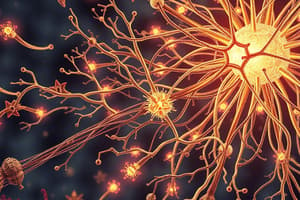Podcast
Questions and Answers
What type of inhibition is seen with triethylcholine?
What type of inhibition is seen with triethylcholine?
- Competitive inhibition (correct)
- Non-competitive inhibition
- Uncompetitive inhibition
- Allosteric inhibition
Which ion is involved in the blockade of Ca2+-mediated exocytosis of synaptic vesicle?
Which ion is involved in the blockade of Ca2+-mediated exocytosis of synaptic vesicle?
- Na+
- Ca2+
- Mg2+ (correct)
- K+
What is the mechanism of action of botulinum toxin?
What is the mechanism of action of botulinum toxin?
- Inhibition of SNARE proteins (correct)
- Activation of SNARE proteins
- Inhibition of choline transporter
- Hydrolysis of membrane phospholipids
What is the effect of β-bungarotoxin on the neuromuscular junction?
What is the effect of β-bungarotoxin on the neuromuscular junction?
What is the primary use of drugs that enhance ACh transmission in the context of botulinum toxin?
What is the primary use of drugs that enhance ACh transmission in the context of botulinum toxin?
What type of blockers are structural analogues of acetylcholine?
What type of blockers are structural analogues of acetylcholine?
What is the primary function of acetylcholinesterase (AChE) in the neuromuscular junction?
What is the primary function of acetylcholinesterase (AChE) in the neuromuscular junction?
How many synaptic vesicles are typically released by a single nerve impulse in the neuromuscular junction?
How many synaptic vesicles are typically released by a single nerve impulse in the neuromuscular junction?
What is the site of action for drugs that inhibit acetylcholine synthesis and release?
What is the site of action for drugs that inhibit acetylcholine synthesis and release?
What is the primary mechanism of pharmacological blockade of the neuromuscular junction?
What is the primary mechanism of pharmacological blockade of the neuromuscular junction?
What is the primary function of the nicotinic receptor in the neuromuscular junction?
What is the primary function of the nicotinic receptor in the neuromuscular junction?
How long do acetylcholine molecules interact with nicotinic receptors in the neuromuscular junction?
How long do acetylcholine molecules interact with nicotinic receptors in the neuromuscular junction?
What happens to sodium in the ion channel when a depolarizing neuromuscular blocker is used?
What happens to sodium in the ion channel when a depolarizing neuromuscular blocker is used?
Why do patients with muscle denervation have an increased risk of heart dysrhythmia or arrest when using depolarizing blockers?
Why do patients with muscle denervation have an increased risk of heart dysrhythmia or arrest when using depolarizing blockers?
What is the main difference between depolarizing and non-depolarizing blockers?
What is the main difference between depolarizing and non-depolarizing blockers?
What is the primary mechanism of action of suxamethonium?
What is the primary mechanism of action of suxamethonium?
Why is suxamethonium used during anesthesia induction?
Why is suxamethonium used during anesthesia induction?
What is a rare but potential side effect of using suxamethonium?
What is a rare but potential side effect of using suxamethonium?
Study Notes
Pharmacological Blockade of the Neuromuscular Junction (NMJ)
Inhibitors of ACh Synthesis and Release
- Hemicholinium: blocks choline transporter, competitive inhibition
- Triethylcholine: blocks ACh synthesis, competitive inhibition, transported into terminal and converted into false neurotransmitter
- Vesamicol: inhibits ACh transport into synaptic vesicle
Inhibitors of ACh Release
- Mg2+: blocks Ca2+-mediated exocytosis of synaptic vesicle
- Aminoglycoside antibiotics (streptomycin, neomycin): specific block of ACh release
- Botulinum toxin (Botox): inactivates SNARE proteins required for exocytosis, high potency, causes botulism, used for relief of muscle spasm, eyelid spasm, and wrinkle removal
- β-Bungarotoxin: hydrolyses membrane phospholipids
Postsynaptic Neuromuscular Blockers
- Act as antagonists (non-depolarizing blockers) or agonists (depolarizing blockers) at nicotinic receptors
- Used during surgery to promote complete muscle relaxation without higher doses of anaesthetic
Depolarizing (Non-Competitive) Neuromuscular Blockers
- Cause continued depolarization leading to repolarization and block of sodium channel
- Prevent further depolarization, leading to twitching becoming flaccid paralysis
- Muscle twitching is short-lived
- No ganglionic block, except at very high doses
- Side effects: bradycardia, post-operative muscle pain, apnea, hyperkalemia, increased intraocular pressure, prolonged paralysis, and malignant hyperthermia
Studying That Suits You
Use AI to generate personalized quizzes and flashcards to suit your learning preferences.
Description
This quiz covers the key components of the neuromuscular junction and various drug strategies for modulating its function. Topics include neuromuscular junction blockade and its pharmacological applications. Assess your knowledge of neuropharmacology and pharmacology in this lecture-based quiz.




